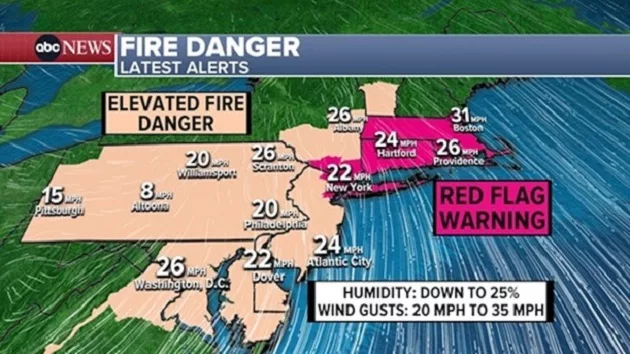
(NEW YORK) — The majority of bird species in the U.S. face a grim future in coming decades if environmental efforts, such as mitigating climate change and decreasing habitat degradation and loss, are not implemented on a larger scale.
More than half of bird species in the U.S. are in decline, with plummeting populations across nearly all habitats, according to the U.S North American Bird Conservation Initiative’s 2022 State of the Birds report published in October.
About 70 species of birds have lost at least half of their populations in the past 50 years, and are poised to lose the other half in the next half-century if conservation efforts are not significantly ramped up, the report states. Those 70 species are not yet listed as threatened or endangered, but are at a tipping point, according to the report.
“It’s a tough time to be a bird right now,” Dustin Partridge, director of conservation science at New York City Audubon, told ABC News.
Birds face human-induced threats, such as climate change, disruption of natural systems, habitat loss, poaching, poisoning, outdoor cats, collisions into glass windows and the severe decline of bug populations, which many bird species feed on, according to experts.
But it’s important to note that because of the significant challenges all birds face, there should not be individual focus on saving one species of bird, but aim to promote the conservation of all, Partridge said.
Here are some of the most at risk species in the U.S.:
Piping plover
The piping plover, an “adorable” little bird that nests along the beaches of the Northeast and are found throughout the Northeast, Great Plains and Great Lakes, are fairing “really poorly,” Partridge said.
The species was hunted for its feathers — to be used in women’s hats — and experienced a dramatic decline in the 19th and 20th centuries, according to the U.S. Fish and Wildlife Service.
Its population has been on the rebound since 1991, with about 8,000 piping plovers currently in existence.
Gunnison sage-grouse
The Gunnison sage-grouse, an endangered ground-dwelling bird species, is now confined to seven geographically isolated populations in southwestern Colorado and southeastern Utah, according to the U.S. Fish and Wildlife Service.
Colorado Parks and Wildlife showed that the imperiled bird’s average count hit a historic low in 2020, with fewer than 1,600 birds remaining at the time,
Colorado Parks has partnered with the FWS and the U.S. Bureau of Land Management to conduct conservation efforts, such as building relationships with landowners to protect the sage grouse habitat, since much of it exists on private property.
Ivory-billed woodpecker
The ivory-billed woodpecker, a species that use to be found in the Southern U.S. and Cuba, is likely now extinct — with the last confirmed sighting occurring in 2004 in east Arkansas, John White, founder and CEO of Birda, a bird-watching app, told ABC News.
There were “pretty serious efforts” to prevent the destruction of the ivory-billed woodpecker’s habitat and ensure its safety, he added.
Some species have recovered significantly after conservation efforts
Scientists and bird enthusiasts are witnessing the fruits of their conservation labor, as populations of some bird species continue to grow despite previously being on the brink of extinction.
There has been “amazing recovery” in recent years for several species, especially water fowls, Natalie White, co-founder of Birda, told ABC News.
Here are some of the species with populations that have rebounded:
Bald eagle
The fate of the United States’ national bird, the bald eagle, hung in the balance, with populations dipping as low as 470 pairs, John White said.
Now, biologists believe there are up to 300,000 bald eagles roaming the country, he added, describing the recovery as “remarkable.”
As a result, bald eagles are no longer considered an endangered species, with their status currently listed as “least concern” on the IUCN’s Red List of Threatened Species.
California condor
The California condor, a terrestrial bird found from California to the Grand Canyon, may still be listed as critically endangered, but its populations have rebounded enough to allow birders to breathe a sigh of relief that they won’t be disappearing any time soon.
The majestic species is the largest terrestrial bird in North America with a wingspan of about 9 feet.
The species dwindled to as low as 22 individuals in 1982, but after successful captive breeding and reintroduction programs, those numbers jumped up to more than 500, with about 330 of the birds living in the wild, John White said.
But the California Condor has a long way to go until it can sustain its populations by itself, according to experts.
“They’re still teetering on the edge,” he added.
Whooping crane
In the 1800s, whooping crane could be found from Canada and as far as northern Mexico, John White said.
Whooping crane populations dropped as low as 21 pairs in 1941, but captive breeding and reintroduction programs in the 1960s have increased the number of whooping cranes to about 660 pairs, John White said.
It may “sound like a lot,” but those conservation efforts need to continue indefinitely to ensure that whooping cranes don’t disappear from the planet, he added.
How to participate in conservation efforts, according to the experts
- Record everything you see, because that data is valuable for researchers, John White said.
- Leaving windows dirty is one of the best things people can do to prevent collisions, Partridge said.
- Keep cats inside, Sierra McDaniel, the program manager for the Hawaii Volcanoes National Park’s natural resources division, told ABC News.
- Go outside and connect with nature, as you’ll be more likely to fight to preserve it, John White said.
- Consider donating to organizations such as BirdLife International, the Audubon Society, the American Bird Conservancy and the World Wildlife Fund, John White said.
Copyright © 2023, ABC Audio. All rights reserved.





